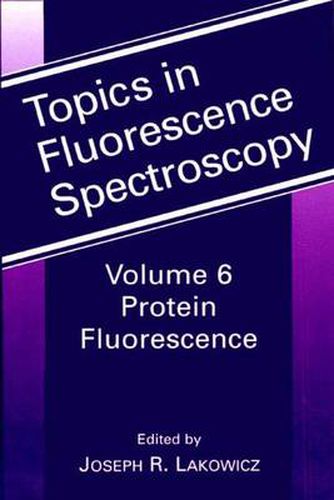Readings Newsletter
Become a Readings Member to make your shopping experience even easier.
Sign in or sign up for free!
You’re not far away from qualifying for FREE standard shipping within Australia
You’ve qualified for FREE standard shipping within Australia
The cart is loading…






This title is printed to order. This book may have been self-published. If so, we cannot guarantee the quality of the content. In the main most books will have gone through the editing process however some may not. We therefore suggest that you be aware of this before ordering this book. If in doubt check either the author or publisher’s details as we are unable to accept any returns unless they are faulty. Please contact us if you have any questions.
The intrinsic or natural fluorescence of proteins is perhaps the most complex area of biochemical fluorescence. Fortunately the fluorescent amino acids, phenylalanine, tyrosine and tryptophan are relatively rare in proteins. Tr- tophan is the dominant intrinsic fluorophore and is present at about one mole % in protein. As a result most proteins contain several tryptophan residues and even more tyrosine residues. The emission of each residue is affected by several excited state processes including spectral relaxation, proton loss for tyrosine, rotational motions and the presence of nearby quenching groups on the protein. Additionally, the tyrosine and tryptophan residues can interact with each other by resonance energy transfer (RET) decreasing the tyrosine emission. In this sense a protein is similar to a three-particle or mul- particle problem in quantum mechanics where the interaction between particles precludes an exact description of the system. In comparison, it has been easier to interpret the fluorescence data from labeled proteins because the fluorophore density and locations could be controlled so the probes did not interact with each other. From the origins of biochemical fluorescence in the 1950s with Prof- sor G. Weber until the mid-1980s, intrinsic protein fluorescence was more qualitative than quantitative. An early report in 1976 by A. Grindvald and I. Z. Steinberg described protein intensity decays to be multi-exponential. Attempts to resolve these decays into the contributions of individual tryp- phan residues were mostly unsuccessful due to the difficulties in resolving closely spaced lifetimes.
$9.00 standard shipping within Australia
FREE standard shipping within Australia for orders over $100.00
Express & International shipping calculated at checkout
This title is printed to order. This book may have been self-published. If so, we cannot guarantee the quality of the content. In the main most books will have gone through the editing process however some may not. We therefore suggest that you be aware of this before ordering this book. If in doubt check either the author or publisher’s details as we are unable to accept any returns unless they are faulty. Please contact us if you have any questions.
The intrinsic or natural fluorescence of proteins is perhaps the most complex area of biochemical fluorescence. Fortunately the fluorescent amino acids, phenylalanine, tyrosine and tryptophan are relatively rare in proteins. Tr- tophan is the dominant intrinsic fluorophore and is present at about one mole % in protein. As a result most proteins contain several tryptophan residues and even more tyrosine residues. The emission of each residue is affected by several excited state processes including spectral relaxation, proton loss for tyrosine, rotational motions and the presence of nearby quenching groups on the protein. Additionally, the tyrosine and tryptophan residues can interact with each other by resonance energy transfer (RET) decreasing the tyrosine emission. In this sense a protein is similar to a three-particle or mul- particle problem in quantum mechanics where the interaction between particles precludes an exact description of the system. In comparison, it has been easier to interpret the fluorescence data from labeled proteins because the fluorophore density and locations could be controlled so the probes did not interact with each other. From the origins of biochemical fluorescence in the 1950s with Prof- sor G. Weber until the mid-1980s, intrinsic protein fluorescence was more qualitative than quantitative. An early report in 1976 by A. Grindvald and I. Z. Steinberg described protein intensity decays to be multi-exponential. Attempts to resolve these decays into the contributions of individual tryp- phan residues were mostly unsuccessful due to the difficulties in resolving closely spaced lifetimes.